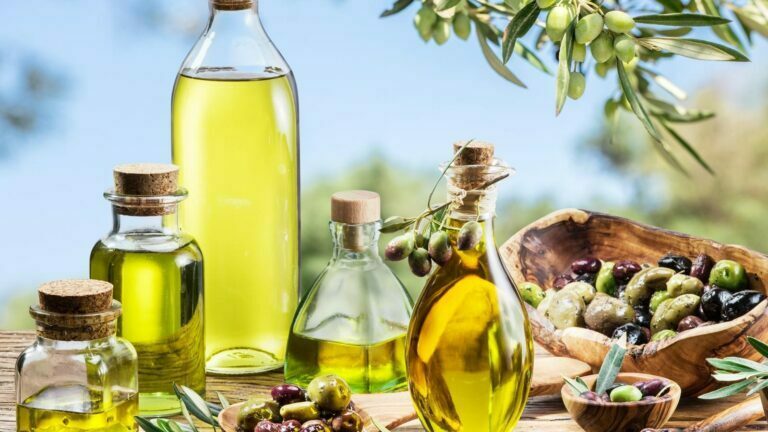Plant oils are a standard pantry staple often used for cooking practices like sautéing or frying vegetables, making sauces, drizzling onto pizzas, and preventing pasta from sticking together.
Olive oil and Vegetable oil are a number of the foremost popular plant oils used around the globe, each displaying unique characteristics.
This blog looks at the differences between olive oil & vegetable oil, including their taste, nutrition, best uses, and potential health benefits.
Comparison between olive oil and vegetable oil
Olive oil and vegetable oil vary in how they are made, their best cookery uses, flavors, and nutritional balance.
Below are some of the main comparison between olive oil and vegetable oil:
Processing and flavor
Once plant oils have been extracted they are usually cleaned with chemicals and heated to remove impurities and increase their shelf life. The more processing oil experiences, the fewer nutrients and less flavor it maintains.
This is visible when comparing minimally processed extra virgin olive oil, which possesses a distinct olive taste, with vegetable oil, which tends to appear a universal, neutral flavor.
Olive oil is obtained from only pressed olives, with extra virgin olive oil being the smallest processed version.
In opposition, vegetable oil is made by mixing oils from different sources, such as cottonseed, canola, soybean, sunflower, safflower, and corn. Thus, more processing is required to remove impurities and make a neutral-flavored blend.
Nutrition
The degree of processing that an oil experiences not only changes its quality but also its nutritional balance.
While both olive oil and vegetable oils contain unsaturated fatty acids, olive oil contains higher amounts of monounsaturated fats like oleic acid, palmitic acid, and linoleic acid. Vegetable oil, on the other hand, contains mostly omega-6 polyunsaturated fats.
Monounsaturated fats have anti-inflammatory and heart-health advantages, whereas omega-6 polyunsaturated fats can be pro-inflammatory and harm heart health if consumed in excess.
It’s also worth noting that the more refining oil experiences, the fewer micronutrients and healthy compounds it retains excess virgin olive oil — the least processed type of olive oil — is rich in antioxidants or anti-inflammatory compounds like tocopherols, polyphenols, and carotenoids. Minimally refined olive oil also maintains some micronutrients, such as vitamins K and vitamins E.
On the opposite hand, the refining process used to make vegetable oil destroys micronutrients, antioxidants, and beneficial plant compounds, including phytosterols, tocopherols, coenzyme, and polyphenols.
Also Read – Healthy Moong Bean Sprouts Salad | Sprouts Salad made with sprouts
Similarities between olive and vegetable oil
Vegetable oil and Olive oil tends to possess similar smoke points, sitting around 400°F (205°C). The smoke point of an oil is the temperature to which it is often heated before its fat begins to break down into glycerol and release fatty acids.
Just as vegetable oil, some kinds of olive oil are highly processed, including pomace oil. These kinds lack micronutrients, and the characteristic flavor that you get from extra virgin olive oil, featuring instead a more neutral taste.
Refined olive oils don’t add “extra virgin” or “virgin” on the label, indicating their higher-level processing. Hence, an easy way to ensure you grab a flavor-packed oil from the store that also preserves some nutrients is to look for these phrases.
Which oil is more healthy?
Olive oil, particularly extra virgin, is among the least processed cooking oils. This means it keeps the most antioxidants, vitamins, and minerals. Olive oil has been broadly researched for their heart health benefits.
Vegetable oil, on the contrary, undergoes a lot of processing to neutralize its flavor and blend various types of plant oils. This means it has least beneficial nutrients, leaving just empty calories.
Replacing vegetable oil for olive oil may also benefit brain health.
If you continue to consume oils, extra virgin olive oil tends to be a way healthier choice than most vegetable oils and vegetable oil blends.
Conclusion
Olive oil and vegetable oil are both widely used in cooking.
While olive oil is extracted from olives and tends to be less processed, vegetable oil is typically a blend of various plant oils and highly processed into a neutral-tasting product.
The processing of vegetable oil leaves it lacking in many of the healthy micronutrients and plant compounds which will rather be found within the plants used to make it. It is also high in omega-6 fatty acids, which may contribute to inflammation.
Also Read – 3 Healthy Tricolour Food Recipes To Make This Patriotic Day
Extra virgin olive oil, on the contrary, retains various trace vitamins and minerals and is rich in antioxidants and anti-inflammatory monounsaturated fatty acids which will benefit heart and brain health.
While olive oil and vegetable oils have different cookery uses, the healthiest option is extra virgin olive oil, which is the least processed and offers the most beneficial compounds.
We, at Crypto Food, offer several tips about the healthy food in our life and the other important aspects of the food. We tend to assist you to arrange specifically for varied food varieties and supply you with complete help to browse our weblog to grasp additional tips.
FAQ
Q1 Is olive oil better than other oil?
Ans Olive oil is one of the healthiest cooking oils and can be used to prepare many different foods. It is perfect for cooking light meals and is widely used in a number of Italian and Spanish dishes.
Q2 Is extra virgin olive oil healthy?
Ans Extra virgin olive oil retains various trace vitamins and minerals and is rich in antioxidants and anti-inflammatory monounsaturated fatty acids which will benefit heart and brain health.
Q3 Is olive oil a good choice for a day to day cooking oil?
Ans That depends. Olive oil doesn’t have a very high smoking point which makes it unsuitable for foods that should be cooked at about 200 °C (400°F), especially if you use extra virigin oil that has an even lower smoking point.

